Transitional Human Fossils
Six Million Years of Human Ancestry
|
Hominid Timelines
|

Hominid Time Line
: A colorful family tree, fossils, tools, use of fire, genetics and natural selection.
Hominid Time Chart : To 60 mybp.
Primate Speciation Rise of Hominids, timeline and group descriptions.
Hominid Species : from talkorigins.org
Describes 18 hominid & earlier species.
TIME.com - Human Evolution Timeline
Hominid Clade Tree showing an example of uncertainty of arrangement.
|

Information on the Internet about human evolution is immense. Unfortunately, it is
scattered among many sources, some of the best of which -- science journals -- require costly subscriptions to read.
It is regrettable also that most of the photographic evidence that is web-available is limited to skulls. Other comparative skeletal
material such as the progression of pelvises, knees, hands and feet are equally interesting but are not web-available.
Rather than attempt to write a textbook on the subject, I have collected from numerous web sources significant information
on a number of aspects of human evolution. The box at right, for instance, has links taking you to a variety of timeline graphics.
Please visit these and try to note some of the differences in the presentations. Although some species of fossil hominids are today
represented by up to 500 specimens, for many there are but a few -- not enough, and not complete enough in some cases, to be certain
as to the position within our family tree. So there is debate within paleoanthropology about the matter -- healthy debate that requires
more evidence before consensus is reached on all points. Also, some of the timelines do not show the latest fossil discoveries and, in a
few cases, two species shown in one timeline are "lumped" together in others. See also the timeline discussion below.
Despite these differences, we now have a least 18 forms of hominid fossils spanning the last 6 million years. There is a section
below for each of these. I also provide links to the most important and comprehensive websites that provide a broad overview of human evolution.
Some of these, particularly the textbooks and college courses, cover many more topics than I attempt to include on this page.
Anthropology includes the study of human cultures, archaeology, paleontology and more. On this page I include information about paleontology
and physical anthropology as they pertain to evolution (although some of the websites that are linked to cover the entire field).
If you are interested in the cultural and archaeological aspects of human history, please visit my Anthropology page.
|
The Hominid Transitional Timeline
See the box at right, above, for several more timelines
|
|
At the time Charles Darwin wrote On The Origin of Species (1859), we had no fossils of Human ancestors.
Through tremendous effort in searching for fossils the next chart can show about 13-14 "links" between modern Humans and our Gorilla
cousins, going back about 5 of the 10 million years to our split in lineage. For each of the species in this chart there are from 5 to 500
fossil or sub-fossil specimens. We have the most specimens for Neanderthals. As new fossil sites are discovered it may be expected
that our confidence in this chart will grow (or it will be modified) and that even more intermediate links will appear on it.
Indeed, since I wrote that paragraph for my Introduction to Evolution page, a range of new fossils have
been found, including: Ardipithecus ramidus kadabba, 5.2-5.8 mybp in Ethiopia, Kenyanthropus platyops,
3.5 mybp in Kenya, Orrorin tugenensis, 6 mybp, also in Kenya, and Sahelanthropus tchadensis, 6.5 mybp in Chad.
The graphic timeline shown here is modified from one used by the BBC in several recent articles. My larger graphic just below, based
upon 1995 data, will have to be modified to include the new fossils after the debate within paleoanthropology reaches some degree of consensus
as to the validity of the taxa and their importance.

In the graphic above only fossil genera are shown with a timeline. In the one below, closely following one produced in the journal
Nature, all of the commonly discussed species are shown but without attempting to illustrate hypothesized lines of descent.
Notice that the species designated as Australopithecus habilis (below) is called Homo habilis in the cladogram that follows it, and
three species of Paranthropus are referred to Australopithecus in the following cladogram. These are taxonomic decisions made by different authors.
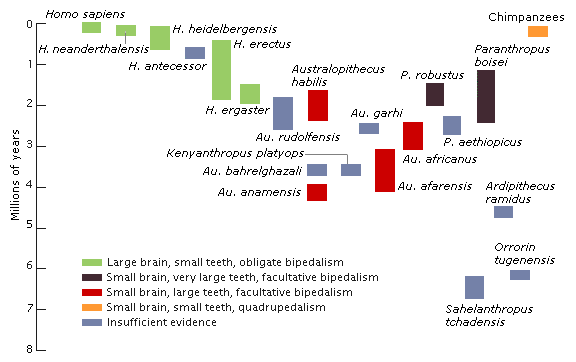
Note that as many as 4 or 5 species of early hominids were living at the same time. Observe also that, in at least a half-dozen instances,
a parental species continued to exist for a lengthy period of time after a daughter species evolved. The arrangement shown here is not accepted
by all paleoanthropologists. For instance, there are some who would merge H. erectus and H. heidelbergensis, considering them as one species.
Also, there are those who maintain the H. neanderthalensis is a subspecies of H. sapiens while many others disagree.
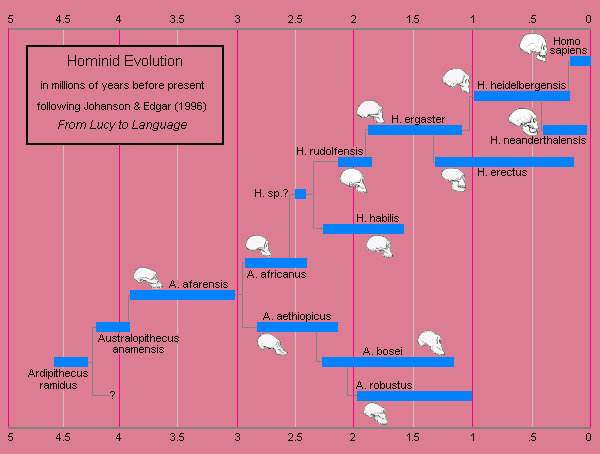
|
|
Transitionals in the Human Fossil Series
|
|
www.talkorigins.org
is an outstanding website. The artwork below, depicting a series of human skulls, came from there. Their larger version
of the artwork is prettier, and they have many pages on their website regarding human evolution and this fossil series.
The links, just below the artwork, will take you to the
Human Origins Program at the Smithsonian Institution. There you will see still larger skull photos and much descriptive material about transitional specimens.
|
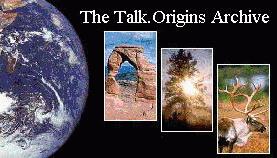
|
|
The transitional series does not only include skulls, of course. While skulls provide evidence for gradual evolution of many features such as
brain size, other bones involving the pelvis, knees and feet show us the transition to bipedality (upright stance) and increase in stature. Below the
next picture and its links you will find the sections for all hominid species.
|
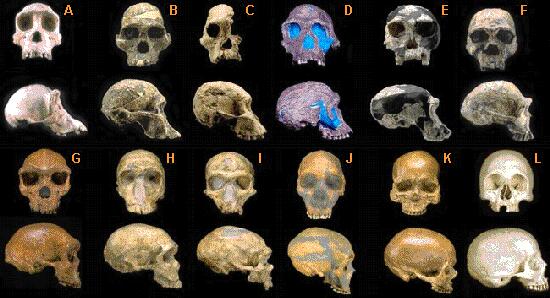
|
A. Pan troglodytes, chimpanzee, modern
B.
Australopithecus africanus,
STS 5, 2.6 My
C.
Australopithecus africanus,
STS 71, 2.5 My
D. Homo habilis,
KNM-ER 1813, 1.9 My
E. H. habilis,
OH24 , 1.8 My
F.
H. ergaster (H. erectus),
KNM-ER 3733, 1.75 My
|
G. H. heidelbergensis, "
Rhodesia man," 300-125ky
H.
Homo neanderthalensis,
La Ferrassie 1, 70ky
I.
H. neanderthalensis,
La Chappelle-aux-Sts, 60ky
J.
H. neanderthalensis,
Le Moustier, 45ky
K.
Homo sapiens,
Cro-Magnon I, 30ky
L. Homo sapiens, modern
|
|
Overview Websites
|
|
The Jones, Smiths, Macys and Darwins : This is my page introducing evolution as
demonstrated by family trees. If you do not understand branching points in evolution, and why we did not descend from monkeys, you might
benefit from reading this before going on.
Human Origins, Species Profiles and Imagery :
This is a wonderful website with extensive descriptions of each hominid species. Individual pages from this site are listed in the species sections below.
Physical Anthropology Tutorials Menu
: Covers 16 broad topics in Physical (Biological) Anthropology such as early theories of evolution; basic
principles of genetics; primate, hominid & human evolution.
Creative Impulse - Prehistory
: This is a tremendous web resource. Although the primary emphasis is on cultural anthropology, there are many fine
links to pages about physical anthropology.
Formenti's Links to Anthropology :
Just about everything in Anthropology. A great reference website.
The Long Foreground: Human Prehistory
: GenEd 101: an introductory college course includes:
1. Overview of Human Evolution
2. Hominid Species Timeline
3. Human Physical Characteristics
Hominid Skull Recreations
: from an online merchant offering teaching quality reproductions. An example of one of their products may be seen
below at Lucy's skull.
Fossil Hominids
: from Talk.Origins archive, simply one of the best websites on the Internet. These web pages are intended to refute
creationist claims that there is no evidence for evolution or human evolution. Their evidence is solid science, and in depth. My praise for
this organization is insufficient to do them justice.
The Human Origins Program at the Smithsonian Institution
: A fine website with a lot of information. Links to their principal pages for individual fossil species are
provided under the group of skulls above, and in the species accounts below. Some of the taxonomic names used differ from common current usage.
Anthropology 1602
: A course at Univ. of Minnesota, rich in information at websites specific to this course as well as at Museums
and other sources. If you are a serious student, mine this resource mother load.
Becoming Human: Paleoanthropology, Evolution and Human Origins
: In 1974 paleoanthropologist Donald Johanson found an elbow bone poking from sediments in Ethiopia that belonged to
3.2-million-year-old Lucy, then the oldest known human ancestor. This website from Johanson's Institute of Human Origins at Arizona State University,
uses multimedia in telling the story of Lucy and human evolution.
Anthropology from Minnesota :
This is one of those Wow!!! websites that are wonderful to visit. It contains a wealth of beautiful material on on all facets
of anthropology. The separate pages under physical anthropology dealing with fossil species are provided also in the accounts below as "emuseum" links.
A Look at Modern Human Origins
: This site is intended to help students of paleoanthropology in research, and to provide information to laypersons who may
do not understand human evolution. There is a very extensive glossary of terms in paleoanthropology. Links to fossil species pages are shown
in the species accounts below (as Kreger).
Time-Space Chart of Hominid Fossils
: This site attemps to catalogue photographic evidence of fossil specimens. Links to fossil species pages are
shown in the species accounts below (Heslip).
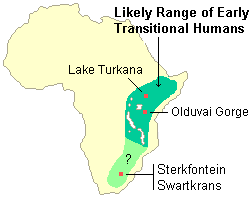
 Early Transitional Humans
: The striking similarities in appearance between the human genus Homo and our distant ancestors, the genus
Australopithecus, is sufficient reason to place us both along with the genus Paranthropus into the same biological family (Hominidae).
All three genera are bipedal and habitually upright in posture. The map at right is from this website.
Early Transitional Humans
: The striking similarities in appearance between the human genus Homo and our distant ancestors, the genus
Australopithecus, is sufficient reason to place us both along with the genus Paranthropus into the same biological family (Hominidae).
All three genera are bipedal and habitually upright in posture. The map at right is from this website.
On-Line Biology Book
: A chapter on human evolution from modified lecture outlines that have developed over many years of teaching college-level introductory biology.
Human Evolution :
Studies in evolutionary biology have led to the conclusion that human beings arose from ancestral primates. This association was hotly
debated among scientists in Darwin's day. But today there is no significant scientific doubt about the close evolutionary relationships
among all primates, including humans. This is a summary which, while the last word here, perhaps ought to be read first.
|
|
Homo sapiens [includes Cro-Magnon]
|
|
ArchaeologyInfo |
Kreger |
Heslip |
PBS
Smithsonian :
Whichever model (if either) is correct, the oldest fossil evidence for modern humans is about 130,000 years old in Africa,
and there is evidence for moderns in the Near East before 90,000 years ago.
Fossil Evidence for Human Evolution in China :
It includes a picture gallery of important fossil specimens, maps detailing the distribution of human fossils, and a time line.
|
|
Homo floresiensis
|
|
Microcephaly refuted: Feb. 2, 2025
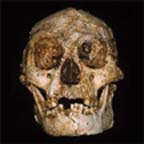
Wikipedia entry
Journal of Human Evolution: October, 2025
|
|
Homo neanderthalensis
|
|
Smithsonian |
emuseum |
ArchaeologyInfo |
PBS
Neandertal Type Site Revisited
: in Proceedings of the National Academy of Science 99 (20):13342-13347 (2002) : Interdisciplinary investigations
of skeletal remains from the Neander Valley, Germany. At least three individuals are represented in the skeletal sample. Radiocarbon dates
for Neandertal 1, from which a mtDNA sequence was determined in 1997, and a second individual indicate an age of 40,000 yr for both.
mtDNA analysis on the same second individual yields a sequence that clusters with other Neandertal sequences.
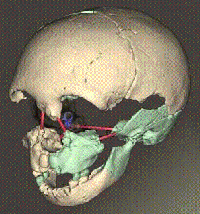
 Computer-assisted Paleoanthropology: : Computers have brought
new life to fossil studies. Instead of just examining bones, researchers now digitize them, then fill in missing pieces, add flesh, and
simulate gait and other features. This tutorial describes work using computer-assisted paleoanthropology to study Neandertals.
Fossils are put through a computed tomography scan, reconstructed in 3D, then compared with modern humans. This photo is from one of many
extremely interesting and thought provoking graphics at this website.
Computer-assisted Paleoanthropology: : Computers have brought
new life to fossil studies. Instead of just examining bones, researchers now digitize them, then fill in missing pieces, add flesh, and
simulate gait and other features. This tutorial describes work using computer-assisted paleoanthropology to study Neandertals.
Fossils are put through a computed tomography scan, reconstructed in 3D, then compared with modern humans. This photo is from one of many
extremely interesting and thought provoking graphics at this website.
Two New Neanderthals Turn Up : Palaeontologists strike gold in
nineteenth-century rubbish. You wait the best part of a century for a lost Neanderthal skeleton to be rediscovered, and then two come along in a week.
Neandertal DNA Sequencing
: These results do not rule out the possibility that Neanderthals contributed other genes to modern humans. However, the results
support the hypothesis that modern humans arose in Africa before migrating to Europe and replacing the Neanderthal population with little or no interbreeding.
|
|
Homo antecessor (Archaic Homo sapiens)
|
|
Kreger |
Heslip |
AMNH
Three new human skulls from a Middle Pleistocene site in Spain
: A .pdf file photocopy of a classic paper in paleoanthropology from Nature 362, 534–537 (1993).
The "Pit of Bones" near Burgos in Spain is a treasure-trove of information on the first Europeans. At around 300,000 years old,
these skulls may have been close to the ancestry of the classic cave-man, Neanderthal Man.
Atapuerca, Home of Humanity?: In 1994 archaeological
digs on the hill of Atapuerca in northern Spain revealed a possible new human species, Homo antecessor, that some scientists
argue is the common ancestor of modern humans and Neandertals. This is a beautiful website to visit and learn about paleoanthropology. It is, however, written in Spanish.
In the Beginning was the Vowel
: Humans were able to talk 300,000 years ago, new research has shown. Pre-Neanderthals who lived in northern Spain could
utter basic vowel sounds, say researchers working at the Atapuerca archaeological site in Burgos Province.
A Hominid from Spain : By 1997 over 1600 human remains
had been excavated, representing at least 32 individuals, the largest repository of fossil humans from the Middle Pleistocene. Most of these
have been found in Sima de los Huesos. They include a complete skull and several other crania.
See Bermúdez de Castro, J. M. et al., A Hominid from the Lower Pleistocene of Atapuerca, Spain: Possible Ancestor to Neanderthals and Modern Humans.
Science 276:1392-1395 (1997).
Gutin, JoAnn C., Remains in Spain Now Reign As Oldest Europeans. Science 269:754-755 (1995).
Parés, J. M. and A. Pérez-Gonzalez. 1995. Paleomagnetic Age for Hominid Fossils at Atapuerca Archaeological Site, Spain. Science 269:830-832 (1995).
Archaic Homo :
This species is often also referred to as "Archaic Homo sapiens." According to some proponents of the "Out of Africa" hypothesis,
most of these specimens should be assigned to H. heidelbergensis, which may have been ancestral to Neanderthals in Europe and to H. sapiens
in Africa. Multiregionalists view this group as evidence of a transition toward modern H. sapiens.
|
|
Homo heidelbergensis (Archaic Homo sapiens)
|
Smithsonian |
Kreger |
Heslip |
ArchaeologyInfo |
PBS

Archaic Homo :
This species is often also referred to as "Archaic Homo sapiens." Many examples of so-called Archaic H. sapiens
have been located, including some recent spectacular finds at Atapuerca, in northeast Spain. These remains of many individuals
include some that may be 780,000 years old. According to some proponents of the "Out of Africa" hypothesis, most of these specimens
should be assigned to H. heidelbergensis, which may have been ancestral to Neanderthals in Europe and to H. sapiens in Africa.
However, in May 1997, the discoverers of the fossils elected to name the fossils a new species, H. antecessor. Multiregionalists view
this group as evidence of a transition toward modern H. sapiens.
Skulls :
The Australian Museum has a page with numerous views of skulls of Homo heidelbergensis.
|
|
Homo erectus (see also H. ergaster)
|
|
Smithsonian |
emuseum |
ArchaeologyInfo |
Kreger |
Heslip |
PBS
Early Homo erectus Skeleton from West Lake Turkana, Kenya
: A .pdf file photocopy of a classic paper in paleoanthropology from Nature 316, 788–792 (1985).
This report of a young but surprisingly tall young Homo erectus male raises many questions about our own African genesis, and the origins of
that very human feature called "childhood."
Multiregional Hypothesis -- H. erectus in China :
Nanjing Man's age suggests that Asian erectus had a longer time to evolve into modern hominids than previously thought. This makes it less
likely for modern hominids from Africa to have replaced Asian erectus. [see older fossils of H. erectus from Republic of Georgia]
Fossil Evidence for Human Evolution in China : It includes a picture gallery
of important fossil specimens, maps detailing the distribution of human fossils, and a time line.
|
|
Homo ergaster (see also H. erectus)
|
|
Smithsonian |
ArchaeologyInfo |
Kreger |
Heslip |
BBC
Homo ergaster in Eurasia (May 2025) :
A nearly complete fossil cranium and another skullcap, representing the earliest known human ancestors from Eurasia,
may also belong to the first hominid species to journey out of Africa. A team of Georgian, German, French and U.S.
esearchers describe these First Eurasians from the site of Dmanisi in the Republic of Georgia in the 12 May issue of Science.
See Gabunia, L., et al., Science 288:1019-25 (2000)
. pdf file Earliest Pleistocene Hominid Cranial Remains from Dmanisi, Republic of Georgia: Taxonomy, Geological Setting, and Age.
Later finds at the same site are called H. erectus.
Fossil Signs of First Human Migration Are Found : Scientists digging in the Republic of Georgia have found 1.7-million-year-old fossil human
skulls that show clear signs of African ancestry and so may represent the species that first migrated out of Africa.
Early Human Evolution: Homo ergaster and erectus :
The ergaster fossils were earlier, dating 1.8-1.5 million years ago, and have been found only in East Africa. The erectus discoveries mostly
date 1.2-0.4 million years ago and have been found widespread in Africa, Asia, and Europe. The approach taken in this tutorial is to treat these
two possibly distinct, but closely related, species as one -- Homo erectus.
Homo ergaster : Many aspects of Homo ergaster and Homo erectus
anatomy are, of course, similar, with the principal differences being a higher cranial vault, thinner cranial bone, absence of sagittal keel, and
certain cranial base characteristics in Homo ergaster. One distinguishing feature between early Homo and ergaster/erectus involves increased brain
size (ranging between 850 and 1100 cc, with an increase over time), although the increase in body size actually means that the relative brain size
has increased but little.
|
|
Homo rudolfensis
|
|
Smithsonian |
ArchaeologyInfo |
Kreger |
Heslip |
Evidence for an Advanced Plio-Pleistocene Hominid from East Rudolf, Kenya
: A .pdf file photocopy of a classic paper in paleoanthropology from Nature 242, 447–450 (1973).
Richard Leakey, son of Louis, describes a skull as iconic as they come, but always known enigmatically as "1470." Thought to belong to an early
form of Homo (now H. rudolfensis), this specimen is a key fossil in the understanding of human origins.
|
|
Homo habilis
|
|
Smithsonian |
emuseum |
ArchaeologyInfo |
Kreger |
Heslip |
BBC |
PBS
A New Species of the Genus Homo from Olduvai Gorge
: A .pdf file photocopy of a classic paper in paleoanthropology from Nature 202, 7–9 (1964).
Leakey scores again with fossils associated with primitive tools. He announces Homo habilis, "handy man," the first fossil member of our own genus;
and with him, the first stirrings of technology.
|
|
Australopithecus africanus
|
|
Smithsonian |
ArchaeologyInfo |
Kreger |
Heslip |
PBS
Man-Ape of South Africa : A
.pdf file photocopy of a classic paper in paleoanthropology from Nature 115, 195–199 (1925) When R. A. Dart, an anatomist
from South Africa, reported the first "ape-man." He was derided by the same people who fell for the fraudulent Piltdown Man. But Piltdown was a
fake and Dart was vindicated. The modern study of human origins starts here.
|
|
Australopithecus [Paranthropus] robustus
|
|
Smithsonian |
emuseum |
ArchaeologyInfo |
Kreger |
Heslip |
PBS
Most Complete Apeman Skull Ever Excavated
: Paranthropus robustus, a hominid that lived between 1.5 million and 2 million years ago, was a vegetarian that may have used rudimentary bone tools.
|
|
Australopithecus [Paranthropus] boisei
|
|
Smithsonian |
emuseum
| ArchaeologyInfo |
Kreger | Heslip
| BBC |
PBS
A New Fossil Skull from Olduvai : A .pdf file
photocopy of a classic paper in paleoanthropology from Nature 184, 491–493 (1959). Fossil-hunter Louis Leakey had been scouring East Africa for
clues about human origins in vain for 30 years before he (or rather, his wife) hit the jackpot at Olduvai Gorge in Tanzania. The new player on the fossil
scene was lantern-jawed "Nutcracker man."
|
|
Australopithecus [Paranthropus] aethiopicus
|
|
Smithsonian |
ArchaeologyInfo | Kreger |
Heslip |
BBC |
PBS
|
|
Australopithecus garhi
|
|
ArchaeologyInfo |
Kreger | Heslip |
| PBS
Pub. Med. : Abstract: Science 284, 23 April, 1999
A New Human Ancestor? :
A. garhi may represent an evolutionary link between the genera of Australopithecus and Homo. It is probably descended from A. afarensis
and adds a potential ancestor for the genus Homo. The remains are from the time when there is very few fossils, between 2.0-3.0 mya.
|
|
Australopithecus bahrelghazali
|
|
Kreger
|
|
Australopithecus afarensis
|
|
Smithsonian |
emuseum |
ArchaeologyInfo |
Kreger |
Heslip |
PBS
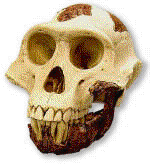 Lucy : How we know what we know? From the Institute of Human Origins.
Lucy : How we know what we know? From the Institute of Human Origins.
Lucy's skull at right came from Hominid Skull Recreations
Plio-Pleistocene Hominid Discoveries in Hadar, Ethiopia : A
.pdf file photocopy of a classic paper in paleoanthropology from Nature 260, 293–297 (1976)
Donald Johanson pushes the human story back beyond the 3-million-year-mark with a skeleton, later assigned to Australopithecus afarensis.
The skeleton is now known as "Lucy," after Lucy in the Sky with Diamonds, the Beatles' tune popular in the field camp.
Pliocene Footprints in the Laetolil Beds at Laetoli, Northern Tanzania :
A .pdf file photocopy of a classic paper in paleoanthropology from Nature 278, 317–323 (1979).
When a volcanic eruption sent a rain of ash over what is now Tanzania, an adult and child, probably both A. afarensis, set out to watch the show —
leaving, as a poignant souvenir, perfect and very modern-looking footprints, preserved in the ashfall.
Ancestors Walked on Knuckles:
Humanity's early ancestors did not walk fully upright, but probably scooted along on their knuckles, like chimpanzees and gorillas do today.
That is the conclusion of two scientists who studied the wrist bones of Lucy, Australopithecus afarensis, and found that she had stiff wrists.
|
|
Australopithecus anamensis
|
|
ArchaeologyInfo |
Kreger | Heslip |
PBS
Australopithecus anamensis :
A new four-million-year-old hominid species from Kenya. Ardipithecus ramidis extended the temporal distribution of hominids to 4.4 Mya.
The relationship between Australopithecus afarensis and Ardipithecus ramidis, a potential ancestral species for all Hominidae, can now be
assessed with more temporally intermediate evidence [by this find].
Leakey, M. et al.,. New four-million-year-old hominid species from Kanapoi and Allia Bay, Kenya. Nature 376:565-571 (1995).
|
|
Kenyanthropus platyops
|
|
Kenyanthropus.com
ABCnews | Heslip
| PBS
New Hominin Genus from Eastern Africa Shows Diverse Middle Pliocene Lineages. : Leakey, M. et al., Nature 410:433-440 (2001).
A 3.5 Myr-old cranium, showing a unique combination of derived facial and primitive neurocranial features, is assigned to a new genus of hominin.
These findings point to an early diet-driven adaptive radiation, provide new insight on the association of hominin craniodental features, and have
implications for our understanding of Plio–Pleistocene hominin phylogeny.
Skull May Alter Views of Human Branching :
The dates for the fossils, ranging from 3.2 to 3.5 million years old, were derived from volcanic ash buried at the site. The sex of the individual has
not been determined.
Flat-faced Man is a Puzzle : Leakey and her fellow researchers have called
the creature Kenyanthropus platyops - the Flat-Faced Man of Kenya - and claim it represents an entirely new branch on our family tree.
|
|
Ardipithecus ramidus
|
|
ArchaeologyInfo |
Kreger | Heslip
| PBS
A New Species of Early Hominid from Aramis, Ethiopia :
A .pdf file photocopy of a classic paper in paleoanthropology from Nature 371, 306–312 (1994).
Now known as Ardipithecus ramidus, this extremely primitive creature was the first member of the human family known from beyond 4 million years ago.
Still controversial, its affinities with the new finds from Chad have yet to be investigated.
See also White, T. D. et al., Corrigendum. Australopithicus ramidis,a New Species of Early Hominid from Aramis, Ethiopia. Nature 375:88 (1995).
A New Species from Ethiopia : Both the antiquity, around 4.4 mya,
and the primitive morphology suggested an ancestral species for the Hominidae. Prior to this publication the earliest hominid species was
Australopithecus afarensis, dated to between 3.0 and 3.6 (possibly 3.8) mya.
|
|
Ardipithecus ramidus kadabba
|
|
Late Miocene hominids from the Middle Awash, Ethiopia
: by Yohannes Haile-Selassie, in Nature 412:178-181 (2001). The abstract states: Molecular studies suggest that the lineages leading
to humans and chimpanzees diverged approximately 6.5–5.5 million years (Myr) ago, in the Late Miocene. Here I report new hominid specimens from the Middle
Awash area of Ethiopia that date to 5.2–5.8 Myr and are associated with a wooded palaeoenvironment. These Late Miocene fossils represent the earliest
definitive evidence of the hominid clade. Derived dental characters are shared exclusively with all younger hominids. This indicates that the fossils
probably represent a hominid taxon that postdated the divergence of lineages leading to modern chimpanzees and humans. However, the primitive dental
and postcranial characters in these new fossils indicates that Ardipithecus was phylogenetically close to the common ancestor of chimpanzees and humans.
Teeth and Bones Stir Human Debate:
An international team of scientists has discovered fossil teeth and bones from a creature they say is the earliest on our branch of the family tree.
But it is not the first such claim and this latest find is sure to stir up further debate about exactly who our earliest ancestors were.
Early Humans Lived In Forests: Carbon isotope evidence
in almost 6-million-year-old soils suggests that the earliest humans already were evolving in – and likely preferred – humid forests over grasslands in Ethiopia.
|
|
Orrorin tugenensis
|
|
Kreger
| PBS
On the Trail of a Few More Ancestors :
If the discoverers are correct, the fossils represent a hominid of an entirely new genus and species. Orrorin means original man in the local dialect.
At an age of 6 million years, it could be one of the first hominids living after their split from lineages leading to other great apes.
First hominid from the Miocene (Lukeino Formation, Kenya) : Senut, B. et al. in January 2025 described Orrorin tugenensis.
The abstract states: Remains of an early hominid have been recovered from four localities in the Lukeino Formation, Tugen Hills, Kenya, in sediments
aged ca 6 Ma. 13 fossils are known, belonging to at least five individuals. The femora indicate that the Lukeino hominid was a biped when on the ground,
whilst its humerus and manual phalanx show that it possessed some arboreal adaptations, The upper central incisor is large and robust, the upper
canine is large for a hominid and retains a nan-ow and shallow anterior groove, the lower fourth premolar is ape-like, with offset roots and oblique
crown, and the molars are relatively small, with thick enamel, A new genus and species is erected for the remains.
|
|
Sahelanthropus tchadensis
|
|
Toumai - at Sahelanthropus.com : The fossil nicknamed Toumai is as old as any hominid fossil
found to date, yet its features appear much more human-like than those of other contenders for title of human ancestor.
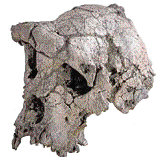 A new hominid from the Upper Miocene of Chad,
Central Africa : Abstract of paper by Brunet M. et al. in Nature 418:145-151 (2002). The search for the earliest fossil evidence
of the human lineage has been concentrated in East Africa. Here we report the discovery of six hominid specimens from Chad, central Africa, 2,500 km
from the East African Rift Valley. The fossils include a nearly complete cranium and fragmentary lower jaws. The associated fauna suggest the fossils
are between 6 and 7 million years old. The fossils display a unique mosaic of primitive and derived characters, and constitute a new genus and species
of hominid. The distance from the Rift Valley, and the great antiquity of the fossils, suggest that the earliest members of the hominid clade were
more widely distributed than has been thought, and that the divergence between the human and chimpanzee lineages was earlier than indicated by most molecular studies.
A new hominid from the Upper Miocene of Chad,
Central Africa : Abstract of paper by Brunet M. et al. in Nature 418:145-151 (2002). The search for the earliest fossil evidence
of the human lineage has been concentrated in East Africa. Here we report the discovery of six hominid specimens from Chad, central Africa, 2,500 km
from the East African Rift Valley. The fossils include a nearly complete cranium and fragmentary lower jaws. The associated fauna suggest the fossils
are between 6 and 7 million years old. The fossils display a unique mosaic of primitive and derived characters, and constitute a new genus and species
of hominid. The distance from the Rift Valley, and the great antiquity of the fossils, suggest that the earliest members of the hominid clade were
more widely distributed than has been thought, and that the divergence between the human and chimpanzee lineages was earlier than indicated by most molecular studies.
Focus on Human Origins : From the journal Nature,
articles and commentary on Sahelanthropus, with .pdf file links to classic past papers in Nature bearing upon hominid fossil finds.
Scientists Clash Over Skull : An expert at London's Natural History Museum says,
of Sahelanthropus, it is the only relatively complete skull so far discovered from a time that has produced very few specimens.
And it was because of this "fossil gap" that he cautioned all researchers not to make grand claims for any find.
|
|
Earlier Primates
|
|
Proconsul africanus : Proconsul is one of the best represented Miocene
hominoid in the fossil record. It lived from approximately 23 to 14 million years ago. See photos of
Proconsul heseloni at the Australian Museum.
Oreopithecus bambolii : is related to Dryopithecus, believed by some
anthropologists to be the ancestor of the great apes. A technical
Paper on Oreopithecus may be seen here. This species is sometimes called a sort of "aquatic ape" or "waterside species" in opposition to the
concept of upright hominids coming down from trees to exploit expanding African savannah. Upright tendency has evolved more than once.
 Tiny Fossil May Link Lower Primates With Humans
: Fossil bones of an animal no bigger than a shrew and weighing less than an ounce have been identified as belonging to the earliest
known relative in the primate lineage that led to monkeys, apes and humans.
Tiny Fossil May Link Lower Primates With Humans
: Fossil bones of an animal no bigger than a shrew and weighing less than an ounce have been identified as belonging to the earliest
known relative in the primate lineage that led to monkeys, apes and humans.
Sivapithecus indicus (jaw only)
|
|
DNA Evidence for Human Evolution
|
|
Mitochondrial DNA and Human Evolution : A
.pdf file photocopy of a classic paper in Human Genetics from Nature 325, 31–36 (1987).
A molecular bombshell that traces the human story by comparing mitochondrial DNA frrom modern humans. The message is clear — all modern
humans have their roots in Africa, and surprisingly recently, between 100,000 and 200,000 years ago.
Retroviruses Demonstrate Human Evolution : From
Proceedings of the National Academy of Science 96 (18): 10254-10260 (1999). Genomes of humans are riddled with thousands of
endogenous retroviruses (HERVs), the proviral remnants of ancient viral infections of the primate lineage. Many HERVs, including the ones
used in this study, result from integration events that took place 5 to 50 million years ago, as indicated by the distribution of specific proviruses
at the same dna sites (or loci) among related species. [In plain English, HERVs demonstrate evolution by means of descent from common ancestors.]
Mitochondrial DNA and Human Evolution : Mitochondrial DNAs from 147 people,
drawn from five geographic populations have been analysed by restriction mapping. They all stem from one woman who is postulated to have lived
about 200,000 years ago, probably in Africa. All except the African population have multiple origins, implying that each area was colonised repeatedly.
Genetic Adam never met Eve : The most recent ancestor
of all males living today was a man who lived in Africa around 59,000 years ago, according to researchers. Our most recent common female ancestor is
thought to be a woman who lived in Africa some 143,000 years ago, the so-called Mitochondrial Eve.
Recent African Origin of Humans Revealed by Hominoid Mitochondrial DNAs :
.pdf file by S. Horai, et al., in the Proceedings of the National Academy of Science
17;92(2):532-536 (1955). The abstract states: We analyzed the complete mitochondrial DNA (mtDNA) sequences of three humans (African, European, and Japanese),
three African apes (common and pygmy chimpanzees, and gorilla), and one orangutan in an attempt to estimate substitution rates and divergence
times of hominoid mtDNAs. Using both synonymous and D-loop substitutions, we inferred the age of the last common ancestor of the human mtDNAs
as 143,000 ± 18,000 years. The shallow ancestry of human mtDNAs, together with the observation that the African sequence is the most diverged
among humans, strongly supports the recent African origin of modern humans.
Humans, Chimps Not as Closely Related as Thought? :
From National Geographic News. For decades, scientists have agreed that human and chimpanzee DNA is 98.5 percent identical. A recent study suggests
that number may need to be revised. Using a new, more sophisticated method to measure the similarities between human and chimp DNA, the two species
may share only 95 percent genetic material.
Australian Fossil Challenges Africa Source :
The study is based on the 60,000-year-old so-called Mungo Man skeleton, which was unearthed in New South Wales in 1974
Gene Data Underline Primate Link :
Researchers discovered that human and chimp DNA differs by just 1.24%, half a per cent less than had been thought. Humans differ from gorillas
by 1.62% and from orang-utans by 1.63%, again less than had been believed.
Europe's Seven Female Founders:
Calling them "The Seven Daughters of Eve", Professor Sykes has individually named them Ursula, Xenia, Tara, Helena, Katrine, Valda and Jasmine.
Sykes arrived at his conclusion by studying mitochondrial DNA, which is passed down from mothers to children.
Anthropological Genetics Background:
Genetic methods are now being applied to studies of human-ape divergence, the size and geographic origin of early hominid populations,
and the earliest migrations of anatomically modern humans.
|
|
Primate Taxonomy and Classification
|
|
Family Trees, Phylogenies and Cladograms : Anyone who can understand a family tree has the mental
grasp of how evolution works. On this page I show graphics from many sources, and of varying kinds of artistic renderings. There are subtle
differences among alternative presentations of the same data.
Human Ancestors Phylogenic Tree : A phylogenetic tree
is a graphical means to depict the evolutionary relationships of a group of organisms. This tree shows possible relationships
[according to these authors] among early human species, as we best know them today. The phylogenetic tree from this page is presented in
the discussion below about differences in graphic display methods.
|
|
Hominid Brain Size Increase
|
|
Science Teaching, and the Search for Origins :
Kenneth R. Miller on Human Brains. What are these organisms whose fossil record shows the transition to a new species?
They are us. These data show an increase in size of the cranium from the roughly 400 cc size of our pre-human ancestors, the split between
our genus, Homo, and Australopithecus, and also illustrates just how complete the human fossil record is. The chart shown below is also included at this resource.
Development of the Hominid Brain
The graph below is modified from Dean Falk, Hominid Brain Evolution: Looks Can Be Deceiving
in Science (1998) 280:1714. Additions to data, in numerals, are footnoted below.
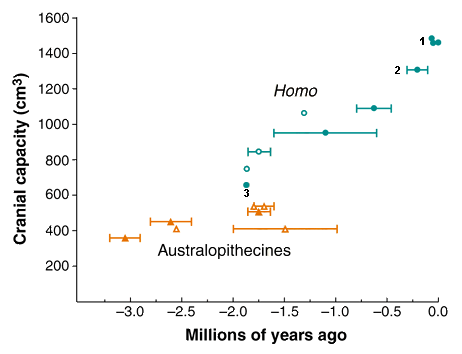
1. Homo neanderthalensis exceeds 1450 cc.
2. Modern Homo sapiens averages ~1350 cc.
3. Vekua A. et al. A New Skull of Early Homo from Dmanisi, Georgia. Science (2002), 297: 85-88.
(Homo erectus/ergaster) ~ 1.75 mybp. Endocranial volume ~600 cc.
Other recent fossils not included in the graph above.
Brunet M. et al. A new hominid from the upper Miocene of Chad, central Africa. Nature (2002), 418:145-51.
(Sahelanthropus tchadensis) ~6-7 mybp. 350 cc.
|
|
Books on Hominid Evolution
The following links will take you to pages at www.amazon.com where, for most items, brief reviews are available.
|
|
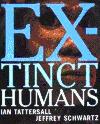  Extinct Humans : by Ian Tattersall and Jeffrey Schwartz.
$21.00. Excerpts from this book can be found above at links provided under individual fossil species.
This is a beautiful book in the hardcover edition, with wonderful photographs, sketches and other graphics. Tattersall pulls no punches
while arguing for the complexity and diversity of the fossil records. The honest cladograms indicate where we need to learn more. If you can
read only one book in this field, this should be the one. My copy is heavily marked and well thumbed.
Extinct Humans : by Ian Tattersall and Jeffrey Schwartz.
$21.00. Excerpts from this book can be found above at links provided under individual fossil species.
This is a beautiful book in the hardcover edition, with wonderful photographs, sketches and other graphics. Tattersall pulls no punches
while arguing for the complexity and diversity of the fossil records. The honest cladograms indicate where we need to learn more. If you can
read only one book in this field, this should be the one. My copy is heavily marked and well thumbed.
Genes, Peoples and Languages : by Luigi Luca Cavalli-Sforza. $13.57
Reconstructing Human Origins: A Modern Synthesis : by Glenn C. Conroy. $68.20
Third Chimpanzee: The Evolution and Future of the Human Animal : by Jared Diamond. $10.50
Lucy: The Beginnings of Humankind : by Donald C. Johanson and Maitland Edey. $10.50
From Lucy to Language: Revised, Updated and Expanded : by Donald Johanson, et al. $43.87
Bioarchaeology: Interpreting Behavior from the Human Skeleton : by Clark S. Larsen. $42.00
Bioarchaeology: The Contextual Analysis of Human Remains : by Jane Buikstra and Lane Beck. $66.72
Origins Reconsidered: In Search of What Makes Us Human : by Richard Leakey. $11.87
Bones of Contention: Controversies in the Search for Human Origins : by Roger Lewin. $20.00
Human Evolution: An Illustrated Introduction : by Roger Lewin. $41.95
Patterns in Evolution: The New Molecular View : by Roger Lewin. $13.97
African Exodus: The Origins of Modern Humanity : by Christopher Stringer. $25.00
The Seven Daughters of Eve: The Science That Reveals Our Genetic Ancestry
: by Bryan Sykes. $18.17
The Last Neanderthal : The Rise, Success, and Mysterious Extinction of Our Closest Human Relatives
: by Ian Tattersall. $17.50
Becoming Human: Evolution and Human Uniqueness : by Ian Tattersall. $11.20
The Fossil Trail: How We Know...... About Human Evolution
: by Ian Tattersall. $11.87
The Human Odyssey: Four Million Years of Human Evolution
: by Ian Tattersall. $17.95
The Wisdom of the Bones: In Search of Human Origins : by Alan Walker and Pat Shipman. $11.70
|
|
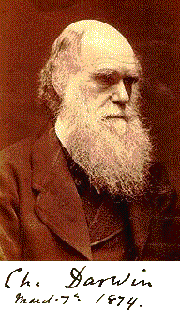
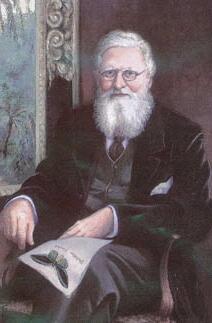










 Lucy : How we know what we know? From the Institute of Human Origins.
Lucy : How we know what we know? From the Institute of Human Origins.
 A new hominid from the Upper Miocene of Chad,
Central Africa : Abstract of paper by Brunet M. et al. in Nature 418:145-151 (2002). The search for the earliest fossil evidence
of the human lineage has been concentrated in East Africa. Here we report the discovery of six hominid specimens from Chad, central Africa, 2,500 km
from the East African Rift Valley. The fossils include a nearly complete cranium and fragmentary lower jaws. The associated fauna suggest the fossils
are between 6 and 7 million years old. The fossils display a unique mosaic of primitive and derived characters, and constitute a new genus and species
of hominid. The distance from the Rift Valley, and the great antiquity of the fossils, suggest that the earliest members of the hominid clade were
more widely distributed than has been thought, and that the divergence between the human and chimpanzee lineages was earlier than indicated by most molecular studies.
A new hominid from the Upper Miocene of Chad,
Central Africa : Abstract of paper by Brunet M. et al. in Nature 418:145-151 (2002). The search for the earliest fossil evidence
of the human lineage has been concentrated in East Africa. Here we report the discovery of six hominid specimens from Chad, central Africa, 2,500 km
from the East African Rift Valley. The fossils include a nearly complete cranium and fragmentary lower jaws. The associated fauna suggest the fossils
are between 6 and 7 million years old. The fossils display a unique mosaic of primitive and derived characters, and constitute a new genus and species
of hominid. The distance from the Rift Valley, and the great antiquity of the fossils, suggest that the earliest members of the hominid clade were
more widely distributed than has been thought, and that the divergence between the human and chimpanzee lineages was earlier than indicated by most molecular studies.
 Tiny Fossil May Link Lower Primates With Humans
: Fossil bones of an animal no bigger than a shrew and weighing less than an ounce have been identified as belonging to the earliest
known relative in the primate lineage that led to monkeys, apes and humans.
Tiny Fossil May Link Lower Primates With Humans
: Fossil bones of an animal no bigger than a shrew and weighing less than an ounce have been identified as belonging to the earliest
known relative in the primate lineage that led to monkeys, apes and humans.

